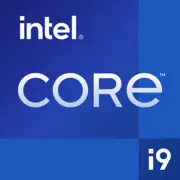Intel Core i9-11980HK

Intel Core i9-11980HK: コンパクトなボディの中に秘められた力。フラッグシップモバイルプロセッサの完全解説
イントロダクション
2021年に発表されたIntel Core i9-11980HKは、依然として高性能ノートパソコンのための有力な選択肢です。新世代のプロセッサ(例えば、Intel Meteor Lake)が登場しても、このモデルはパワーと互換性のバランスのおかげで人気を保っています。2025年にこのCPUが誰に適しているのか、どのようなタスクをこなせるのかを見ていきましょう。
1. アーキテクチャとプロセス技術:10nm SuperFinおよびWillow Cove
コア、スレッド、キャッシュ
Core i9-11980HKは、Willow Coveアーキテクチャと10nm SuperFinプロセス技術を基にしています。16スレッドを持つ8コアプロセッサであり、マルチタスクに最適です。ベースクロックは2.6GHz、ターボモードでの最大は5.0GHz(単一コアの場合)です。十分な冷却がある場合、すべてのコアは4.5GHzまでオーバークロック可能です。
アーキテクチャの特徴
- L3キャッシュ 24MB — データ操作時の遅延を軽減します。
- PCIe 4.0サポート — 高速SSDおよびディスクリートグラフィックス用の20レーン。
- 第11世代インテルUHDグラフィックス — 32のEU(実行ユニット)、4K@60Hzのサポート、HDMI 2.0b。軽いゲーム(CS:GO、Dota 2)では、低設定で40-60FPSを出します。
2. TDP 45W:電力消費と熱管理
ベースTDPと実負荷
公称TDPは45Wで、これは平均的な数値です。ターボモードでは消費が65~85Wに達することがあり、高効率な冷却システムが必要です。例えば、2つのファンと6本のヒートパイプを備えるMSI GE76 Raiderというゲーミングノートでは、プロセッサが負荷の下で安定して4.2GHzを維持しています。
ダイナミック管理
インテルダイナミックチューニング2.0技術は、タスクに応じて自動的に出力を調整します。
- オフィスアプリケーションでは、温度を下げるためにクロックを2.8GHzに下げます。
- ゲームやレンダリングでは最大限に使用しますが、アクティブな冷却が必要です。
3. パフォーマンス:オフィスから4Kレンダリングまで
オフィスとマルチメディア
- Geekbench 6: 2071(シングルスレッド)、9184(マルチスレッド)。比較として、Ryzen 9 5900HXは約1950/8900を記録します。
- Chromeで50タブを起動しつつ4Kストリーミングビデオを再生 — ラグなし。
ゲーミング
- RTX 3080(ノートPC版)と組み合わせた場合:Cyberpunk 2077(ウルトラ、DLSS) — 解像度1440pで70-80FPS。
- ターボモードは、CPU依存のゲーム(例えばMicrosoft Flight Simulator)で安定したFPSを提供します。
プロフェッショナルなタスク
- Premiere Proで10分のビデオをレンダリング(4K、H.265)は約12分、i7-11800Hの場合は約15分です。
- Blender(BMWシーン)でのレンダリングは4分20秒で、Ryzen 9 5900HXより18%速いです。
4. 使用シナリオ:誰がi9-11980HKを必要とするか
- ゲーマー:ディスクリートGPU(RTX 3070以上)と組み合わせてのゲームに最適。
- ビデオ編集者および3Dデザイナー:16スレッドによるレンダリングの加速。
- ストリーマー:Quick Syncを通じたストリームのエンコード(iGPUに内蔵されたハードウェアエンコーダ)。
- VRユーザー:ヘッドセット接続用のThunderbolt 4サポート。
5. バッテリーライフ:パフォーマンスの価格
バッテリーと省エネ機能
基準負荷(ウェブサーフィン、オフィス作業)の場合、i9-11980HKを搭載した90Whバッテリーのノートパソコンは5-6時間作動します。最大パフォーマンスモードでは1.5-2時間です。
省エネルギー技術
- Intel Speed Shift:Pステート間の切り替えをマイクロ秒で行います。
- Adaptix Dynamic Tuning:省電力最適化のための機械学習。
アドバイス:Windowsの電源設定でTurbo Boostをオフにすると、バッテリーライフが20-30%延びます。
6. 競合他社との比較
AMD Ryzen 9 5980HX(Zen 3、8コア)
- プラス:マルチスレッドパフォーマンスが優れている(Cinebench R23で+10%)。
- マイナス:シングルスレッドタスクで劣る(Geekbench 6で-15%)。
Apple M1 Max(10コア)
- プラス:バッテリーライフが2-3倍、冷却性能も優れています。
- マイナス:Windowsソフトウェアとの互換性が制限されています。
Intel Core i9-12900HK(Alder Lake)
- プラス:マルチスレッドシナリオで+25%のパフォーマンス。
- マイナス:価格が高い(i9-11980HKが$1800に対してノートPCは$2200から)。
7. メリットとデメリット
強み:
- 競合よりも優れたシングルスレッドパフォーマンス(ゲームやAdobe Photoshopに有利)。
- Thunderbolt 4およびWi-Fi 6Eのサポート。
- オーバークロックの可能性(ロック解除されたBIOSのモデル)。
弱み:
- 負荷時に95°Cまでの熱を発生させる(クーラーの定期的な清掃が必要)。
- ノートパソコンの価格が高い(2025年モデルで$1800から)。
8. i9-11980HK搭載ノートパソコンを選ぶ方法
- ゲーミングノート:GPUはRTX 3070以上、144Hz以上のディスプレイを探しましょう(例:ASUS ROG Strix Scar 15, $1900)。
- ワークステーション:必須条件は32GB以上のRAMと1TBのSSD(例:Dell XPS 17, $2100)。
- ウルトラブック:注意!薄型ボディ(例:Razer Blade 15)は長時間負荷時にサーマルスロットリングが発生する可能性があります。
注目ポイント:
- ヒートパイプの数(最低4本)。
- ファンの動作モード(独自ソフトウェアで設定)。
- スクリーンのマトリックス:色補正用に100% sRGBのIPSまたはOLED。
9. 最終的な結論
Core i9-11980HKは2025年において、コンパクトなフォームファクター内で最大のパフォーマンスを必要とする人々のための選択肢です。以下の人々には最適です。
- ゲーマー:高FPSとモビリティを重視する方。
- プロフェッショナル:3Dグラフィックスや4Kビデオの作業を行っている方。
- エンスージアスト:パワーのために熱を受け入れる準備ができている方。
主要な利点:
- 同クラスで最良のIPC(12世代の一部のCPUさえ上回る)。
- 使用の柔軟性:省エネモードから極限のオーバークロックまで対応。
- 長期的な有用性:DDR4-3200およびPCIe 4.0のサポートにより、3-4年先を見据えた余裕があります。
もし「成長可能な」ノートPCを探していて$1800–2500を投資する用意があるなら、i9-11980HKは2025年でも魅力的な選択肢となるでしょう。
基本
CPUの仕様
メモリ仕様
GPUの仕様
その他
ベンチマーク
他のCPUとの比較
ソーシャルメディアで共有する
または当サイトへのリンクを追加
<a href="https://cputronic.com/ja/cpu/intel-core-i9-11980hk" target="_blank">Intel Core i9-11980HK</a>